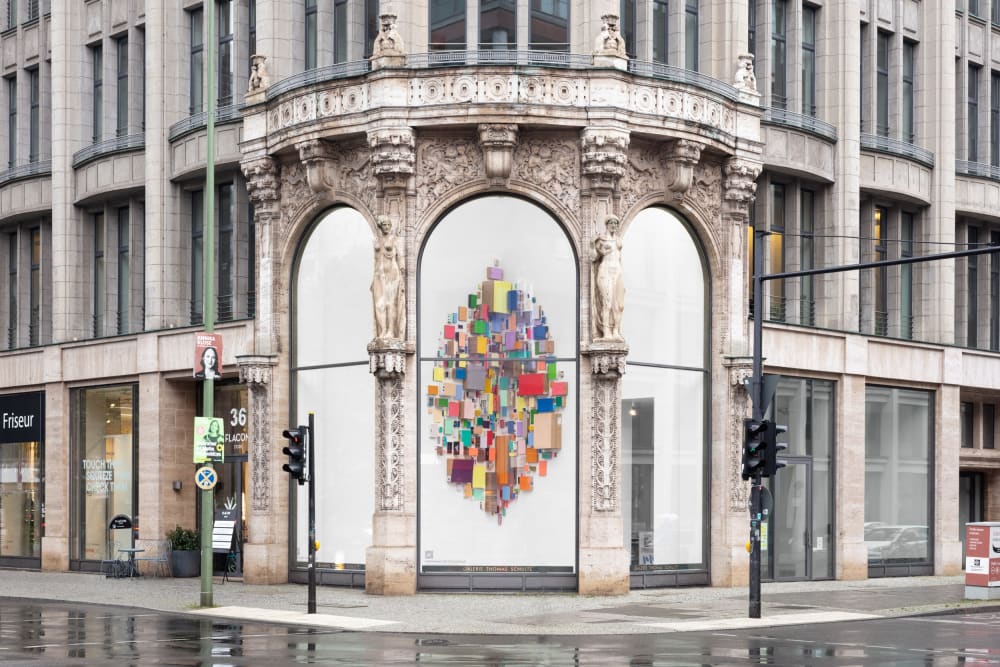Splitogetherness: another groove: Abraham Cruzvillegas
-
Introduction
Galerie Thomas Schulte presents Splitogetherness: another groove, a solo exhibition of new works by Abraham Cruzvillegas. Created on site specifically for the exhibition in Berlin, the works relate to Cruzvillegas’ ongoing practice and series of projects, which he describes as autoconstrucción. Through processes of construction and craft, both material and narrative, they speak to exchange, collectivity, and the relationship between identity and one’s surroundings — ranging from subtle drawings on hand-made paper that slowly reveal themselves to a sprawling yet elusive installation in the gallery’s Corner Space.
Cruzvillegas draws on the dynamics of autoconstrucción, the practice of self-building homes in communities like his childhood neighborhood in Mexico City — a concept he has taken up in his work over the past decades. He connects its innovative use of on-hand materials, rooted in circumstances of precarity and necessity, for the building and adaptation of one’s home to the construction of identity – considering both as continuous works-in-process, with change as a permanent and shared condition. Cruzvillegas takes a correspondingly improvisational approach to creating sculptures and installations, at times floor-based and at others suspended, from a broad scope of found and recycled everyday objects and materials.
Here, the raw materials used for the sculptural works have been found and selected by the gallery’s staff — Cruzvillegas uses what he is given and excludes nothing. It is this collaborative and open aspect that exemplifies autoconstrucción, as communal and inventive practice. The use of locally gathered materials, assembled on site, situates the work in a sense of place – while, what has been consumed, discarded, and reused, may also reflect its broader social, economic, or political dimensions. Processes of destruction and fragmentation coexist alongside those of construction, as disparate elements are brought together in a careful, if impromptu, way. Through such temporary phenomena, the experience of transformation and identity itself – the encounters, human and otherwise, that shape it – are brought to the fore. In this realm of instability, between different modes of existence and meaning, potentiality is found.
In their ephemeral nature, hasty assemblage, and emphasis on process, there is an almost performative element. While Cruzvillegas also activates his installations and exhibitions and creates music and performances, traces of a similar character are carried through his large-format drawings. Made on a surface that is spread out on the floor and imparted with volume through layers of paint and time, the drawings are executed in a matter of minutes using a mop. Composed of fluid, simple strokes and sweeping gestures, like a dance, they call his interest in calligraphy to mind. While their lightness, touch of humor, and quick completion also reflect his background in caricature, as a political cartoonist.
This elemental approach is suited to the subject matter of the large-format drawings. In some, he builds on his long-standing fascination with and depiction of primates, in what he refers to as self-portraits. He has commented that he is drawn to primates for their similarities and close proximity to humans, particularly their manual abilities – the capacity to use their hands, and by extension, tools. It’s a focus on manual processes, along with the social and communal behaviors that these creatures embody, that likewise underpins his sculptural works.
Alongside the drawings of apes and monkeys is another ongoing series, which takes the form of maps. These are similarly distilled to an essence – of lines and points, like glyphs. Paths are intuitively traced between possible destinations, those significant to the artist, mapping his experiences of and relationships to place: here, Berlin. As points of contact rather than focus, they form loose connections – multi-directional motions that render persistent contextual shifts.
The complementary and contrasting primary and secondary colors used in the map drawings extend their elemental quality. Cruzvillegas works with the same base colors – which he refers to as prime matter – in the installation spanning the Corner Space, visible from the intersecting streets outside. The installation continues his Blind Self-Portrait series, in which assorted papers from his everyday life are amassed and obscured, painted over and assembled in geometric, grid-like three-dimensional works. Information and experience are accumulated and transformed into objects – here specifically, documents of the correspondence process between the artist and the gallery leading up to the exhibition, compiled and enclosed within folders that can no longer be opened or read.
The relations and dynamics at play are compounded by a fragmentary nature – even in their joining, elements remain distinct from one another, with something in between: Splitogetherness. There is a similar treatment of language, with its own potential for transformation, in Cruzvillegas’ writing: an integral part of his practice, present here in a companion text. Historical and structural references to doubles, to twins, to two cities – like Berlin – appear in the text and extend into the space. It’s also there in another groove: whether understood as a musical rhythm, a flow, a space carved out with the potential to join two things.
Cruzvillegas speaks of the horizon line: a line that doesn’t exist, but becomes visible through the contrast it defines. To split is also to share – and in the shared space of the exhibition, moments of association, recognition, even déjà vu, may open up: points of encounter that resist singular reference through their own continuous transformation.
Text by Julianne Cordray -
Installation Views
-
Works
-
Inquire about works by Abraham Cruzvillegas
-
Artists on view





















